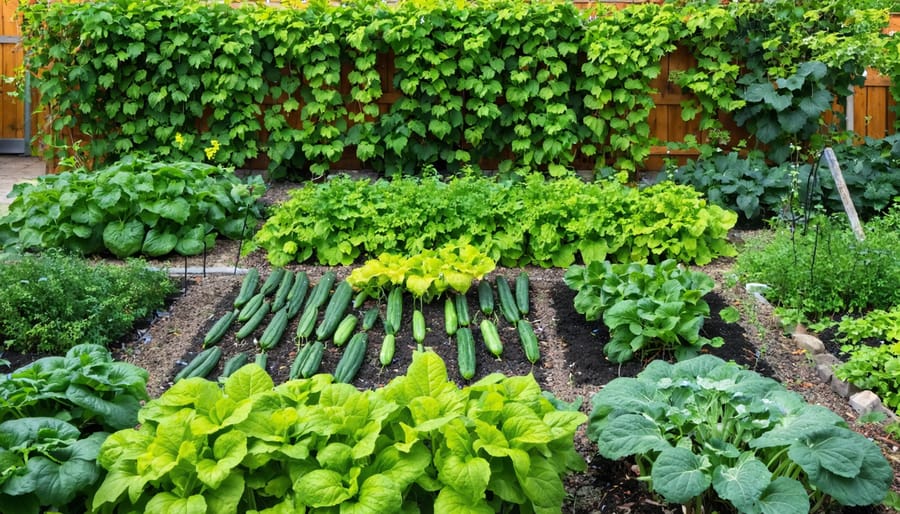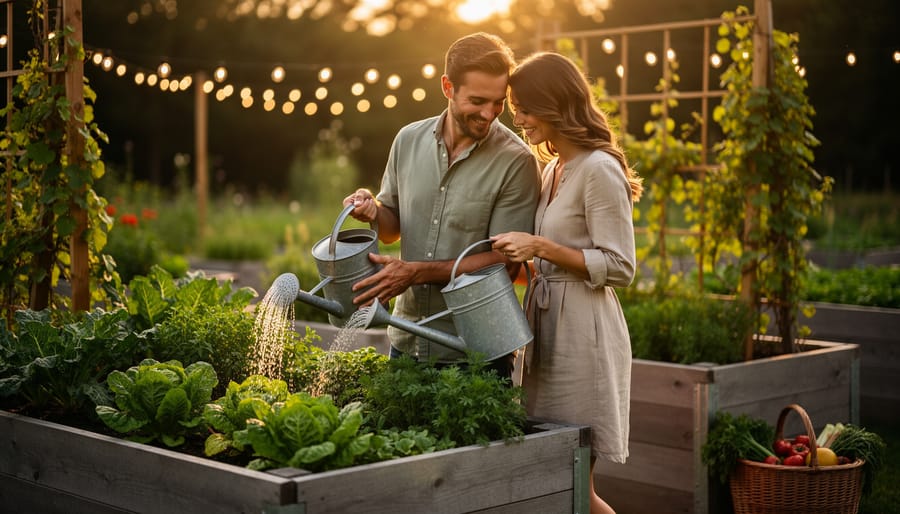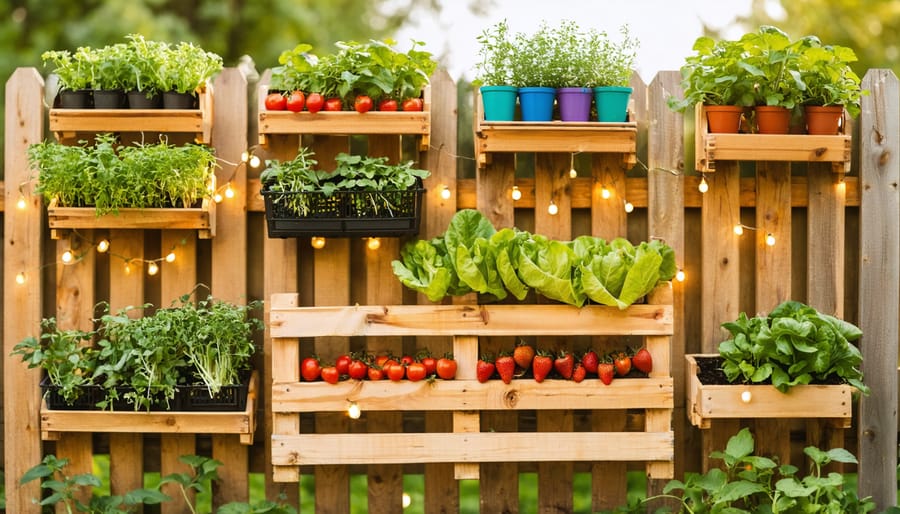Transform your backyard into a thriving food oasis by applying proven edible landscaping principles that blend beauty with functionality. Map your garden’s sunlight patterns throughout the day, identifying prime growing zones for sun-loving vegetables and shadier spots for leafy greens. Layer your plantings vertically – combine climbing beans and trellised cucumbers with ground-covering herbs and strawberries to maximize space and create visual interest. Group plants with similar water needs together, positioning thirsty tomatoes and peppers near each other while keeping drought-tolerant herbs and Mediterranean vegetables in separate zones. This thoughtful approach to edible garden design doesn’t just yield abundant harvests – it creates a stunning outdoor space that nourishes both body and soul, seamlessly integrating productive plants into your existing landscape while maintaining aesthetic appeal throughout all seasons.
Planning Your Edible Garden Layout
Assessing Your Space and Sunlight
Before planning your garden layout, it’s essential to understand your space’s unique characteristics. Start by observing your garden area throughout the day to track sunlight patterns. Most edible plants need at least 6 hours of direct sunlight to thrive, so note which areas receive full sun, partial shade, or full shade.
Draw a rough sketch of your garden space, marking permanent features like buildings, trees, and fences. These elements not only affect sunlight but also influence wind patterns and moisture distribution. Use a compass or smartphone app to determine which direction your garden faces – south-facing areas typically receive the most sunlight in North America.
Don’t forget to consider vertical space! Walls, fences, and existing structures can support climbing plants or serve as windbreaks. Also, check your soil quality by doing a simple soil test and observe how water moves through your space after rain. Understanding these elements will help you choose the right plants for the right spots, maximizing your garden’s productivity and beauty.
Remember, even small spaces can yield abundant harvests when you work with your environment’s natural characteristics.
Designing for Both Beauty and Function
Creating an edible garden doesn’t mean sacrificing beauty for functionality. In fact, some of the most stunning gardens seamlessly blend ornamental appeal with productive growing spaces. The key lies in thoughtful planning and creative plant combinations that please both the eye and the palate.
Start by incorporating edible plants with naturally attractive features. Rainbow chard, with its vibrant stems in gold, pink, and crimson, makes a striking border plant. Purple basil and bronze fennel offer beautiful foliage while providing essential cooking herbs. Even traditional vegetables like artichokes and flowering kale can serve as dramatic focal points with their architectural forms.
Layer your plantings to create visual interest. Tall sunflowers or climbing beans can form living walls, while compact herbs like thyme and oregano make excellent ground covers. Nasturtiums add splashes of color as they trail over bed edges, and their flowers and leaves are completely edible.
Consider adding structural elements that serve dual purposes. An arbor can support grape vines or climbing peas while creating an inviting garden entrance. Decorative obelisks become both artistic elements and natural supports for tomatoes or pole beans. Even practical features like raised beds can be designed with attractive materials that complement your home’s architecture.
Don’t forget to include flowering edibles throughout the season. Calendula, borage, and bee balm attract pollinators while providing edible blooms for salads and garnishes. Plant them alongside vegetables to create colorful companion plantings that benefit both plants and enhance the garden’s overall appearance.
Remember that good design also means considering maintenance. Group plants with similar water needs together, and leave enough space between plantings for easy harvest access. This practical approach ensures your garden remains both beautiful and productive throughout the growing season.
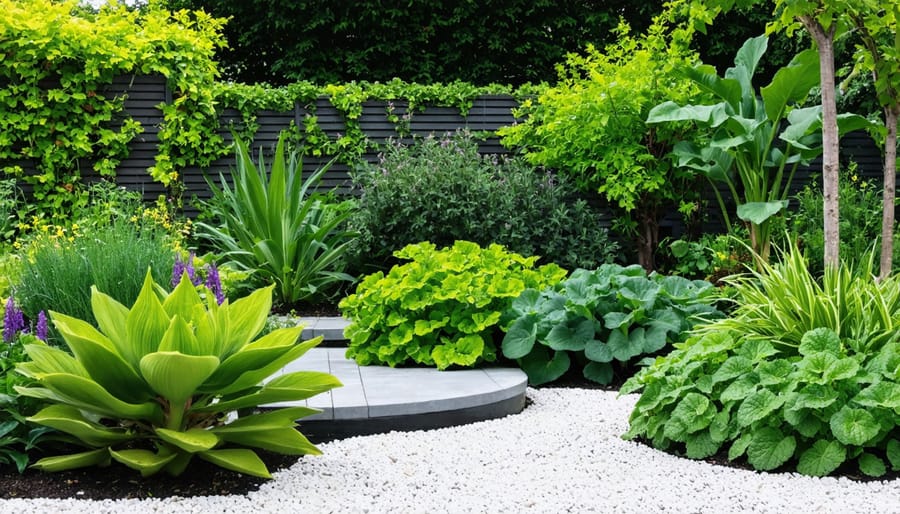
Choosing Your Edible Plants
Combining Vegetables and Herbs
Creating successful plant combinations in your edible garden isn’t just about growing vegetables successfully – it’s about finding partnerships that enhance both flavor and growth. Think of your garden as a community where each plant brings something special to the table.
Tomatoes and basil are classic companions, not only in Italian cuisine but also in the garden. The basil helps repel tomato-loving insects while improving the tomatoes’ flavor. Similarly, carrots and onions form a perfect duo – onions ward off carrot flies, while carrots deter onion pests.
Create aromatic borders by planting lavender, thyme, or sage alongside your vegetables. These herbs not only add wonderful scents to your garden but also attract beneficial pollinators and confuse pest insects with their strong aromas. Plus, they’re excellent for cooking!
Consider the Three Sisters method – a time-tested Native American technique combining corn, climbing beans, and squash. The corn provides support for the beans, which fix nitrogen in the soil, while the squash leaves create living mulch that retains moisture and suppresses weeds.
For small spaces, try vertical combinations: Plant lettuce or spinach beneath climbing peas or pole beans. The taller plants provide partial shade for the leafy greens, extending their growing season into warmer weather.
Remember to include flowers like marigolds, nasturtiums, and calendula throughout your vegetable beds. These edible blooms not only add splashes of color but also help protect your vegetables from harmful insects while attracting beneficial ones.
Adding Edible Flowers
Adding edible flowers to your garden brings a delightful burst of color while offering unique culinary possibilities. These beautiful blooms can transform ordinary salads, desserts, and beverages into stunning culinary creations. Popular choices include vibrant nasturtiums, which offer a peppery kick perfect for salads, and fragrant lavender that adds a subtle floral note to baked goods and teas.
Begin with easy-to-grow varieties like calendula, with its cheerful orange petals that can garnish soups, or bright blue borage flowers that taste like cucumber and look stunning frozen in ice cubes. Pansies and violas are excellent choices for beginners, as they’re hardy, long-blooming, and their sweet, mild flavor makes them perfect for decorating cakes and cookies.
When planning your edible flower garden, consider succession planting to ensure continuous blooms throughout the growing season. Group flowers with similar water and sunlight needs together, and remember to leave space between plants for good air circulation. Always grow your edible flowers organically, avoiding any chemical pesticides or fertilizers.
Some lesser-known but equally delightful options include scented geraniums, whose leaves and flowers add aromatic flavor to drinks and desserts, and gem marigolds, which offer a citrusy taste perfect for seafood dishes. Remember to properly identify flowers before consuming them, as not all flowers are edible, and some can be harmful if ingested.
Harvest your edible flowers in the morning when their water content is highest, and use them fresh for the best flavor and appearance. Store extras between damp paper towels in an airtight container in the refrigerator for up to a week.
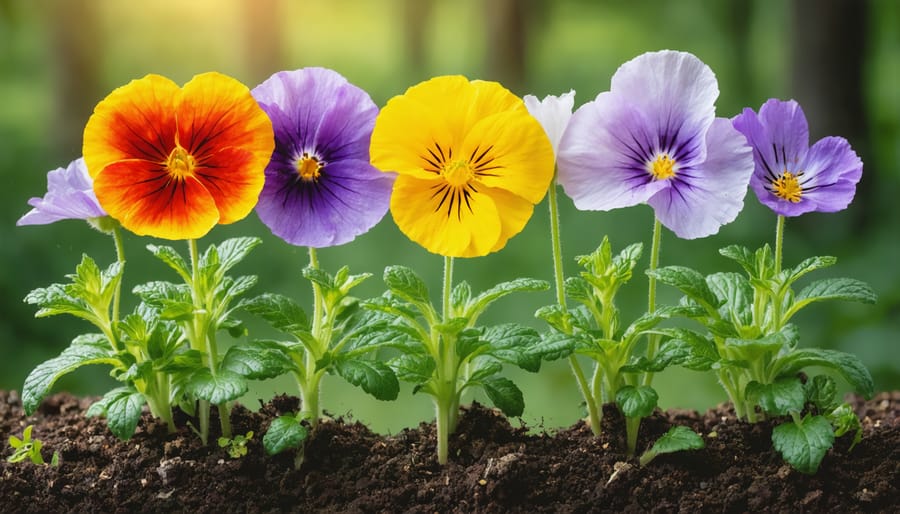
Creating Year-Round Interest
Seasonal Planting Schedule
A well-planned seasonal planting schedule ensures your edible garden remains productive and visually appealing throughout the year. Start by dividing your garden into sections and mapping out what you’ll plant in each season. Early spring is perfect for cool-weather crops like peas, lettuce, and radishes, while late spring welcomes warmth-loving plants such as tomatoes and peppers.
For summer, focus on heat-tolerant vegetables like eggplants, cucumbers, and beans. Plant these in succession every few weeks to maintain a steady harvest. As summer winds down, prepare for fall by sowing quick-growing crops like spinach and Asian greens. Don’t forget to include winter varieties like kale, Brussels sprouts, and root vegetables that can withstand frost.
Consider companion planting to maximize space and create visual interest. Mix flowers like marigolds and nasturtiums among your vegetables – they’re both beautiful and edible. For year-round appeal, incorporate perennial herbs such as sage, thyme, and oregano as permanent garden features.
Keep a garden journal to track planting dates and successes. This helps you refine your schedule each year based on what works best in your climate. Remember that timing may vary depending on your hardiness zone, so adjust accordingly and don’t be afraid to experiment with different planting windows to find what works best in your garden.
Structural Elements and Support
A well-designed edible garden isn’t just about the plants – it’s about creating a strong foundation that supports your growing ambitions. Raised beds are perfect for beginners and experienced gardeners alike, offering better soil control, improved drainage, and easier access for planting and harvesting. Consider building beds 3-4 feet wide so you can reach the center comfortably from either side.
Trellises and vertical supports open up exciting possibilities for growing climbing vegetables like peas, beans, and cucumbers. They not only save space but also add visual interest to your garden. You can create simple DIY supports using bamboo poles and twine, or invest in decorative metal structures that double as garden art.
Arbors and pergolas create enchanting entrances while supporting grape vines or climbing squash. These architectural elements draw the eye upward and create distinct garden rooms. For smaller spaces, obelisks and tuteurs provide elegant support for climbing roses or flowering beans.
Don’t forget about practical elements like paths and borders. Wide, stable paths between beds ensure easy access for maintenance and harvesting. Natural materials like wood chips or gravel work well and complement the garden’s aesthetic. Edge your beds with permanent materials like stone or brick to maintain clean lines and prevent soil erosion.
Remember to incorporate seating areas where you can pause to admire your growing bounty. A simple bench or chair nestled among your edibles creates a perfect spot for garden contemplation.
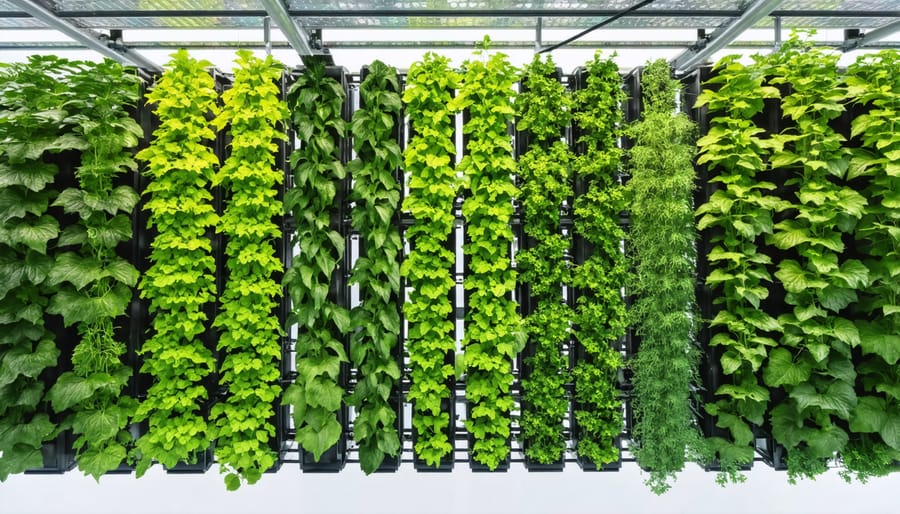
Maintenance Tips for Success
Sustainable Care Practices
Maintaining your edible garden sustainably isn’t just good for the environment – it’s also easier on your wallet and time. By following low-maintenance garden design principles, you can create a thriving ecosystem that practically takes care of itself.
Start by implementing a robust composting system using kitchen scraps and garden waste. This creates a closed-loop system where your garden generates its own nutrients. Layer your compost with both green materials (vegetable scraps, coffee grounds) and brown materials (dried leaves, straw) for optimal decomposition.
Conserve water by installing a drip irrigation system or using collected rainwater. Mulching with organic materials like straw or wood chips helps retain moisture, suppress weeds, and gradually enriches your soil as it breaks down. Apply a 2-3 inch layer around your plants, keeping it away from stems to prevent rot.
Embrace beneficial insects by planting companion flowers like marigolds and nasturtiums throughout your garden. These natural allies help control pest populations without the need for harmful chemicals. Consider creating insect hotels or leaving some areas slightly wild to provide habitat for these helpful garden friends.
Remember to rotate your crops annually to prevent soil depletion and reduce pest problems. Keep detailed records of what grows where, making it easier to plan future rotations and maintain healthy soil for years to come.
Managing Pests Naturally
Keeping pests at bay doesn’t mean you need to resort to harsh chemicals that could harm your garden’s ecosystem. Nature provides numerous effective solutions that can help protect your edible garden while maintaining its beauty. Companion planting is one of the most attractive ways to deter unwanted visitors – marigolds, nasturtiums, and lavender not only add splashes of color but also naturally repel many common garden pests.
Creating habitat for beneficial insects is another elegant solution. Plant flowering herbs like dill, fennel, and borage to attract ladybugs, lacewings, and parasitic wasps that feed on harmful insects. A shallow water feature or bird bath can invite natural predators like birds and frogs to help keep pest populations in check.
Physical barriers can be both functional and decorative. Try using copper tape around raised beds to deter slugs and snails, or install attractive trellises with fine mesh to protect fruits from birds. For larger pests like rabbits or deer, consider incorporating decorative fencing that complements your garden design.
Healthy plants naturally resist pests better, so focus on building rich soil and maintaining proper spacing between plants to ensure good air circulation. A layer of organic mulch not only keeps the garden looking tidy but also provides shelter for beneficial insects while making it harder for pests to reach your plants.
If you spot an issue, start with the gentlest solution first. A strong spray of water often removes aphids effectively, while handpicking larger pests during evening garden walks can become a peaceful daily ritual.
Creating an edible garden is a rewarding journey that brings beauty, sustainability, and fresh flavors right to your doorstep. By carefully planning your space, selecting the right combination of plants, and implementing smart design principles, you can create a garden that’s both productive and visually stunning. Remember that your garden will evolve with time, so start small and expand gradually as you gain confidence. Whether you have a spacious backyard or a modest balcony, there’s always room for growing your own food. The satisfaction of harvesting your first homegrown tomato or picking fresh herbs for dinner makes every effort worthwhile. Take that first step today – sketch your design, prepare your soil, and watch as your edible paradise takes shape. Your journey to a more sustainable and delicious lifestyle begins in your own backyard.

